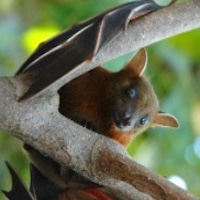Timing of emergence and cave return, and duration of nocturnal activity in an endemic Malagasy fruit bat

All claims expressed in this article are solely those of the authors and do not necessarily represent those of their affiliated organizations, or those of the publisher, the editors and the reviewers. Any product that may be evaluated in this article or claim that may be made by its manufacturer is not guaranteed or endorsed by the publisher.
Authors
Bats emerge from their day roost after dusk and different factors can affect the timing of departure, return, and duration of nocturnal activities. This study provides information on the time of emergence and return of an endemic Malagasy fruit bat, Rousettus madagascariensis, in a cave located in the Réserve Spéciale d’Ankarana, northern Madagascar. Individuals were captured in a narrow passage between the roost and cave exit and capture time for each individual was noted. Variation according to sex, age, and body condition, as well as the influence of season, and the sunset and sunrise time were analyzed. During the dry season, individuals started to emerge at 1913 hours and returned to the cave generally by 0505 hours; the duration of time outside the cave during the dry season was higher in adult females (0952 hours) followed by subadult males (0937 hours), sub-adult females (0931 hours), and adult males (0910 hours). During the wet season, individuals exited at 1926 hours and returned at 0351 hours; as in the dry season, adult females spent more time outside the cave (0833 hours), than sub-adult females (0800 hours), and adult males (0752 hours). The period of emergence varied according to the age and sex classes, and time of predawn return associated with the previous nocturnal activity. The period of return was influenced by season, and age and sex classes. Such information is useful to quantify shifts in bat ecology, especially for endemic species with limited distribution or those playing an important role in ecosystem services.
How to Cite
PAGEPress has chosen to apply the Creative Commons Attribution NonCommercial 4.0 International License (CC BY-NC 4.0) to all manuscripts to be published.







